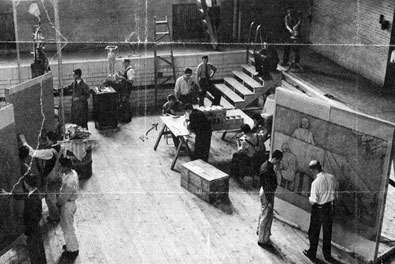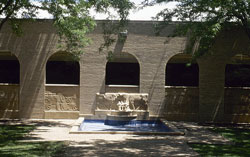Inside Iowa State
Inside ArchivesSubmit newsSend news for Inside to inside@iastate.edu, or call (515) 294-7065. About InsideInside Iowa State, a newspaper for faculty and staff, is published by the Office of University Relations. |
June 3, 2009 
Christian Petersen (white shirt, lower right) works in a swim-pool-converted-to-art-studio on the University of Iowa campus on the mural that would become the cornerstone of Iowa State's public works of art collection. (Photo, Ames Historical Society, Bertrand R. and Mary E. Adams Collection.) FDR's New Deal helped launch art on ISU campusby Diana Pounds While time will tell the impact of the current federal stimulus package, Iowa Staters needn't look beyond the campus to see the effects of the first stimulus effort, which was launched during the Great Depression 75 years ago. 
The "History of Dairying" mural in the Food Sciences Building courtyard, is Iowa's only known surviving public art sculpture created through the New Deal's WPA project. (Photo, Brunnier Art Museum). Two of Iowa State's finest works of art -- Grant Wood's mural in Parks Library and Christian Petersen's mural in the Food Sciences Building courtyard -- sprang from president Franklin D. Roosevelt's New Deal program to boost employment, said Lynette Pohlman, director of university museums. The federal program would lead to other noteworthy achievements at Iowa State. It brought Christian Petersen to campus, where he became the nation's first collegiate sculptor-in-residence. And during his 21-year stay, the prolific sculptor would launch Iowa State's public art program, which has grown into the largest campus collection in the nation. Getting a piece of the PWAP pieThen, as now, there was an art to getting a share of federal stimulus funds. The Public Works of Art Program (PWAP) was one among many New Deal programs and it only lasted from December 1933 to June 1934. Iowa State president Raymond Hughes was able to take advantage of the six-month window of opportunity because he'd already been planning to add works of art to campus and even had a couple of artists in mind -- Wood, who was on faculty at the University of Iowa, and Petersen, who was working in Chicago. A chemist by profession, Hughes believed well-rounded students needed art education, Pohlman said. He already had created a required art appreciation program at Iowa State, and when the PWAP program was announced, he seized the opportunity to beautify campus with works of art. Hughes applied for funds through Wood, who was in charge of the PWAP program in Iowa. Wood hired Petersen and the eager Chicago sculptor was practically on the next train to Iowa, Pohlman said. The University of Iowa connectionIowa State's first two works of public art actually were created in a studio on the University of Iowa campus, Pohlman said. Wood designed the eight murals depicting the beginnings of technology and Iowa State's ag, engineering and home economics divisions and oversaw a team of 14 University of Iowa students in the painting. The panels were displayed first in Corcoran Art Gallery, Washington, D.C., and then installed at Iowa State by staff from the Art Institute of Chicago. Alongside Wood in the studio was Petersen, who created the design and molds for his bas relief mural on the history of the dairy industry. The molds were transported to Iowa State, where Petersen fired the 6.8-by-80-foot terra cotta mural. Petersen originally trained in the decorative Beaux-art style of sculpting, Pohlman said. However, he was greatly influenced by Wood, and his sculptures at Iowa State reflect the regionalism style that became popular in rural America. "The 30s and 40s were tumultuous eras," Pohlman said. "The Spanish Civil War raged. Hitler and Mussolini rose to power, World War II broke out in Europe and economic survival was a common concern for most Americans. Inspiration from the Midwest"Ironically, as a result of the New Deal federal employment programs, this era also was one of the most artistically prolific in American history. Some artists, like Grant Wood and Christian Petersen, sought to establish a unique style that would convey renewed belief in the promise of America. For inspiration, they turned to the Midwest, where the folkways, customs and ideals of farmers and workers provided an endless bounty of reassuring, nostalgic images. With straightforward naturalism, artists depicted the everyday heroism of life on the farm and in small towns." |
SummaryIowa State's public works of art program sprang from an earlier stimulus package -- Franklin D. Roosevelt's New Deal program in the '30s. Quote"Some artists, like Grant Wood and Christian Petersen, sought to establish a unique style that would convey renewed belief in the promise of America. For inspiration, they turned to the Midwest, where the folkways, customs and ideals of farmers and workers provided an endless bounty of reassuring, nostalgic images." Lynette Pohlman, director of University Museums |